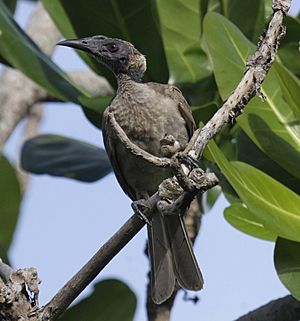Helmeted friarbird facts for kids
Quick facts for kids Helmeted friarbird |
|
|---|---|
 |
|
| Conservation status | |
| Scientific classification | |
| Genus: |
Philemon
|
| Species: |
buceroides
|
The helmeted friarbird (Philemon buceroides) is a unique bird. It belongs to the Honeyeater family. Bird watchers often call it a "leatherhead." This is because of its special look.
Contents
What Does a Helmeted Friarbird Look Like?
The helmeted friarbird has a dark gray face. It also has bright red eyes. Its body is mostly gray-brown. This color fades to white on its chest. As the spotted chest gets closer to its feet, the color becomes darker.
These birds are about 32 to 36 centimeters long. Male friarbirds weigh between 127 and 179 grams. Females are a bit smaller, weighing 92 to 112 grams. The average male is about 38 cm long. This makes it the largest type among the four helmeted friarbirds in Australia.
Where Do Helmeted Friarbirds Live?
You can find the helmeted friarbird mostly along the coasts of the Northern Territory in Australia. They also live in Indonesia. Their homes can be different depending on the specific type of friarbird.
However, they usually live in warm, dry forests. They also like lowland forests and mangrove forests. When building their nests, friarbirds use bark, leaves, and stems. They make a strong home. They also add sticks for extra support and soft grass for comfort. They often build their nests high in trees. This keeps them safe. They also like to build nests close to water.
Life Cycle and Reproduction
Helmeted friarbirds usually breed from September to February. Sometimes, they also breed from February to May or October to December. They do not breed in May or July.
When breeding, a female friarbird usually lays 2 to 4 eggs. Sometimes, they can lay up to 5 eggs. The eggs hatch quickly. It only takes 15 to 18 days for the eggs to incubate.
A helmeted friarbird typically lives for about 5 to 7 years. Scientists believe their population is currently stable. However, they think the number of these birds might drop by 10% in the next 10 years. If this happens, they could become a vulnerable species. This means they would be more at risk.
The population of friarbirds is slowly decreasing. It goes down by 10% with each new generation. Since they only live for 5 to 7 years, this is a concern. We don't know the exact number of friarbirds alive today. But we do know their numbers are declining.
How Do Helmeted Friarbirds Behave?
The helmeted friarbird is a very noisy bird. They make loud "squawks" that you can hear from far away. Their calls often sound like keeyo-keoway or kowee ko keeyo. They can repeat these sounds many times. They also often make a kurr-rk sound. They repeat this slowly, about eight to ten times.
Friarbirds are usually more vocal in the morning. They also call a lot during storms. They are quieter at other times. There are only small differences in how males and females behave.
What Do Helmeted Friarbirds Eat?
The helmeted friarbird eats many different kinds of food. Their main diet includes nectar from flowers, fruits, and seeds. Sometimes, they eat small bugs. Very rarely, they might eat lizards. What they eat can change depending on where they live.
They often gather in groups of 10 to 30 birds. These groups meet around flowering trees and shrubs to find food.
Different Types of Helmeted Friarbirds
There are different types, or subspecies, of the helmeted friarbird. For example, the hornbill friarbird (P. b. yorki) lives in Cape York Peninsula and coastal north-eastern Queensland. Some people think it's a subspecies of the helmeted friarbird. Others think it's a completely separate species. The same is true for the New Guinea friarbird (P. b. novaeguineae).


